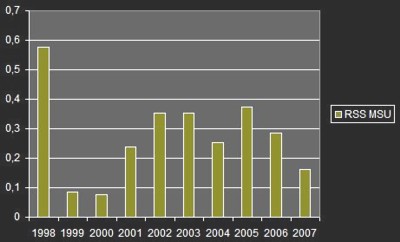Today the USA Today announced in a headline:
Studies Link Man-Made Causes to Rise in Humidity
From the article:
One study, published in today’s edition of the journal Nature, found that the overall increase in worldwide surface humidity from 1973-99 was 2.2%, which is due "primarily to human-caused global warming," according to study co-author Nathan Gillett of the University of East Anglia, in Norwich, U.K.
Here is what makes me immediately suspicious, even at this point in the article: No one can acurately come up with an empirical proof of how much of the warming from 1973-99 was due to man’s activities and how much was due to natural effects (the best you can find are studies that say "most" or "a lot of" or "some". Therefore, it is impossible that anyone was able to attribute a humidity rise just to the man-made portion of the warming, since we don’t know how much that was.
Second, there are been a number of good studies that have shown that man can have a substantial effect on air humidity, but that these effects tend to be due to land use (e.g. agriculture, irrigation, urbanization, and even swimming pools) rather than CO2 caused warming. To throw all of the humidity rise only on CO2, and not these other anthropogenic effects, seems facile.
So how did the study author’s get to their conclusions?
It turns out the only empirical work anyone did was measure humidity. And yes, humidity did seem to go up over the these decades. But this is the end of the empirical work in the studies.
Both studies relied primarily on computer models of the Earth’s climate system to reach their conclusions.
Great. For years I have called these computer models scientific money-laundering. They take unproven assumptions, plug them into something they call a model, and then get results they claim to be proven. They are washing garbage unproven assumptions through these black boxes and then calling them clean results on the back end. Garbage In – Scientific Proof Out. It is crazy. The models are built on the assumption that anthropogenic effects drive the climate, and so they therefore spit out the results that… anthropogenic effects drive the climate.
Roy Spencer, principal research scientist at the University of Alabama-Huntsville, says, "The main thing they’re trying to show is that the recent warming and moistening in the last 30 years is outside the range of natural variability, and that man is causing the warming. The use of climate models to do this is not convincing. … The idea that you can use climate models as a surrogate for reality is circular reasoning."
I often tell my friends that when you really flay away all the bullshit, the main argument by climate catastrophists for anthropogenic origens of climate change is that scientists "can’t think of anything else it can be." In other words, having exhausted all the natural causes the current state of the science knows about, they assume the cause must be man. My friends never believe me when I say this, but here is a climate scientist in his own words:
"Natural variability in climate just can’t explain this moisture change. The most plausible explanation is that it’s due to the human-caused increase in greenhouse gases," Santer says. His study also discounted influences from solar activity and the 1991 eruption of Mount Pinatubo.
This is the heart of the "link" trumpeted in the article’s headline — that scientists can’t imagine that the cause is natural varaiblity and that it is plausible man is the cause. Wow, that’s good science. And by the way, can you imagine if, say, astrophysics took the same approach? "We don’t know of any natural phenomenon that would cause pulsars so they must be man-made." This is science Percival Lowell would have loved.


